
 |
Eager Space | Videos by Alpha | Videos by Date | All Video Text | Support | Community | About |
|---|


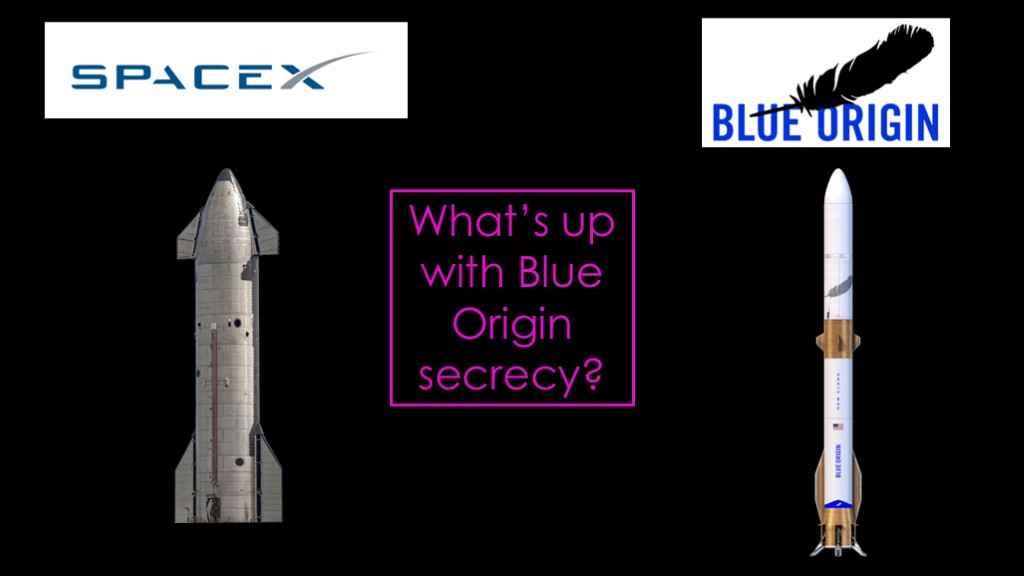
Why are some spaceflight companies so secretive and why are others so open?
The idea for this video came from a question of a viewer, who wrote, "what's up with blue origin secrecy?".
I wrote a short answer that I didn't like, wrote some more, and pretty soon realized that the topic deserved a video of its own.
We'll start with SpaceX because they started the openness trend.
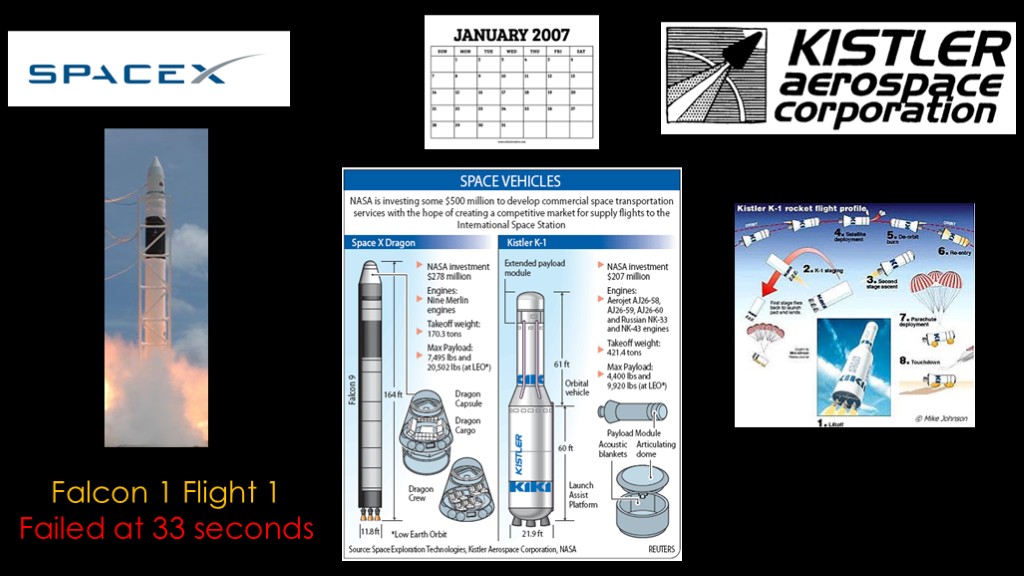
As is often the case, we need to roll the calendar back a few years, to 2007. SpaceX and Kistler Aerospace had been awarded NASA contracts to fly cargo - and perhaps, someday, crew - to the international space station. This was a critical need as the shuttle was going to be retired in 3 years.
The Kistler K-1 was intended to be a fully reusable vehicle, with the first stage boosting back to the launch site and landing with parachutes and airbags, and the second stage using a similar approach.
Kistler had been working on the design since 1994. NASA liked Kistler because it was run by George Mueller, the head of the office of manned space flight during the 1960s.
At the time of the award, SpaceX had performed one test launch of its Falcon 1 rocket, which failed at 33 seconds into the flight.
Both of these were speculative vehicles.
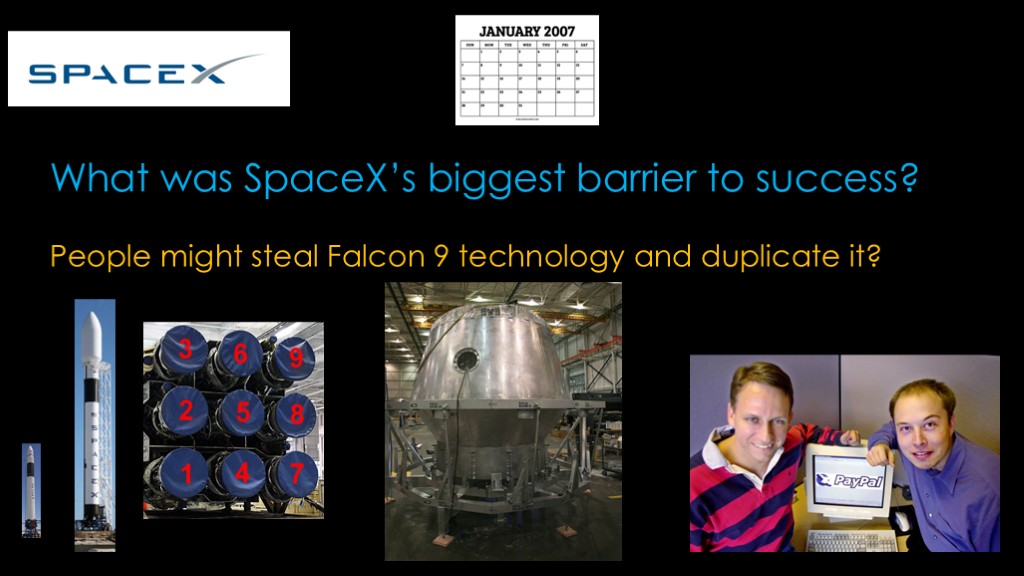
In this time period, what was spacex's biggest barrier to success?
Was it that people might steal falcon 9 technology and duplicate it?
With the possible exception of the Merlin engine - which was still in early development - Falcon 9 was a really boring rocket, deliberately so. Who would steal it?
SpaceX had a bigger problem.
Falcon 9 was a big step up from Falcon 1 and used a ridiculous 9 engines on the first stage plus they were building a capsule. And the company was run by a guy who made his money doing internet stuff.
Conventional wisdom was that they would fail.
SpaceX had a PR problem. To be successful, they needed not only to keep NASA happy with their progress, they needed to be able to sell to commercial satellite companies, and they really wanted to get some of the Air Force money that ULA had a monopoly on at the time.
They needed people to take them seriously.

And somebody asked an interesting question
What if we do everything in the open?
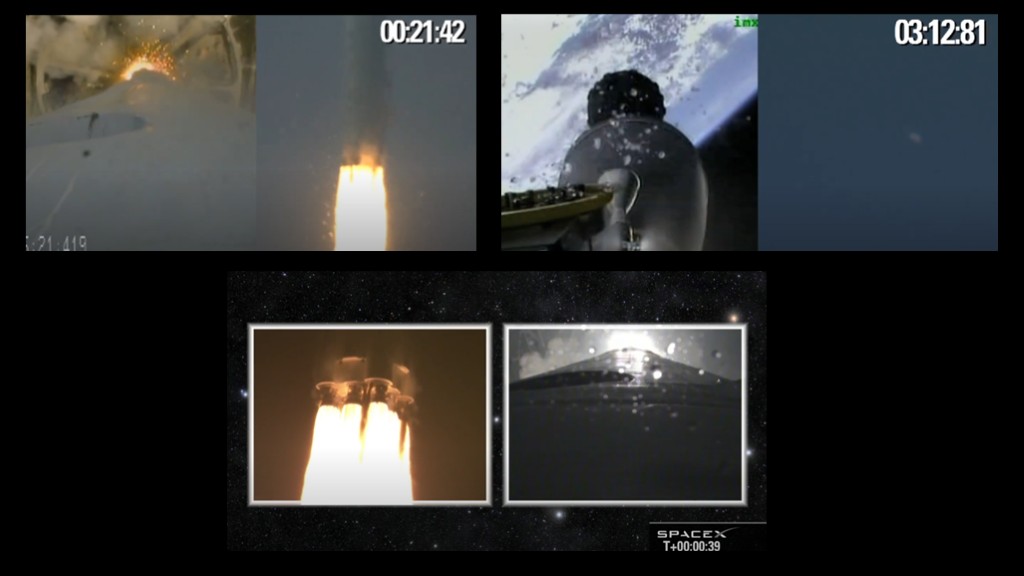
With the first Falcon 9 launch, we got tracking views and multiple onboard cameras. That wasn't unprecedented - ULA did that for Atlas V - but it was a sign that SpaceX was interested in being open.
We got nice shots during the first operational flight - CRS-1 - but it was frankly footage that only a rocket nerd could love.
And then somebody decided to raise the bar.

That is an absolutely wonderful video - great camera work, great views, great music and - most importantly for SpaceX - a great advertisement for the company and Falcon 9.
https://www.youtube.com/watch?v=V-zG5QvlBaw
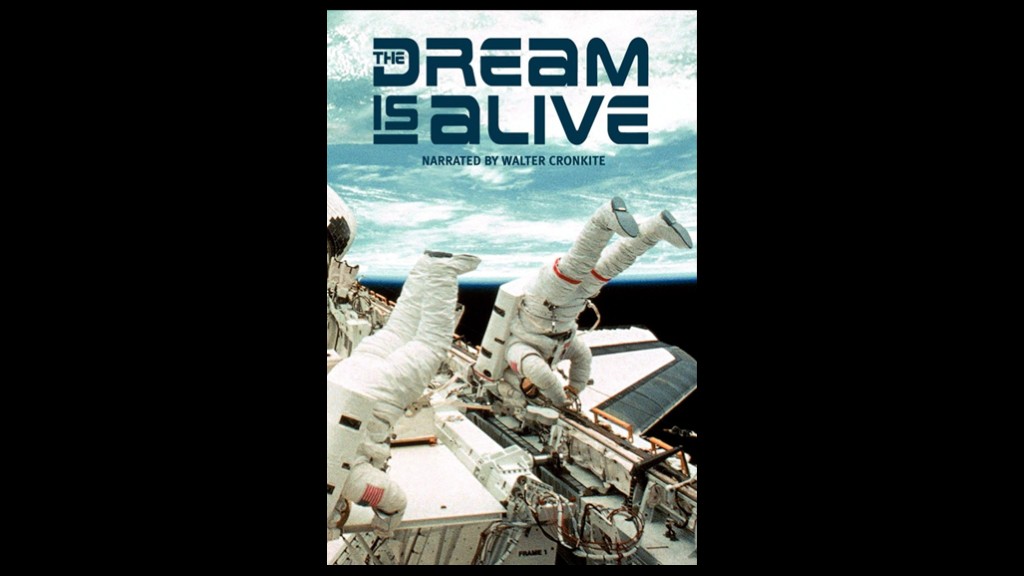
It reminded me of the dream is alive, a wonderful IMAX movie about the space shuttle from way back in 1986.
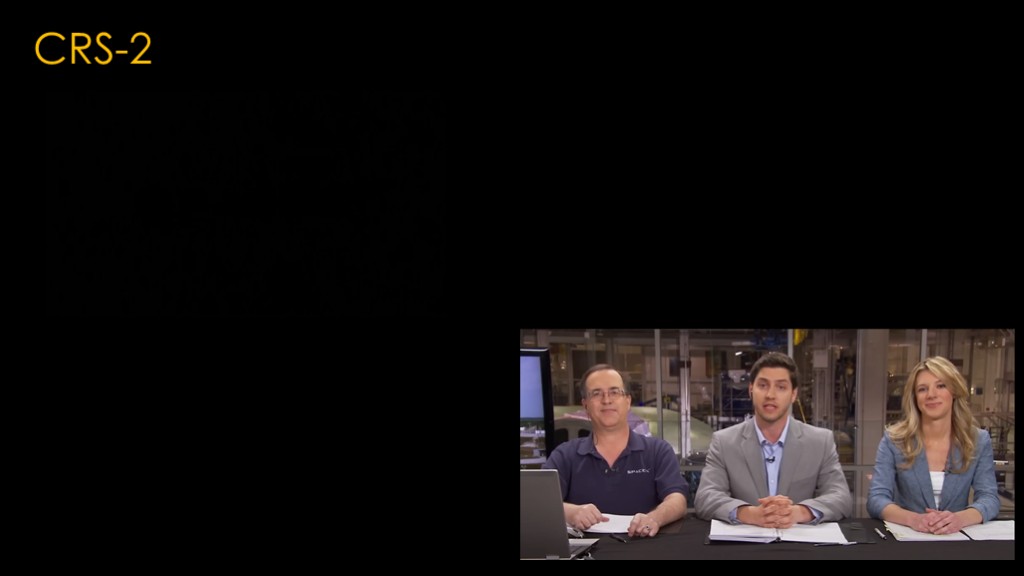
Then came CRS-2, and launches had become a full production.
We got an intro video at the start of the webcast, and multiple *technical* people to explain and narrate what is going on and why we should care about it.
SpaceX had made space launches interesting and exciting.
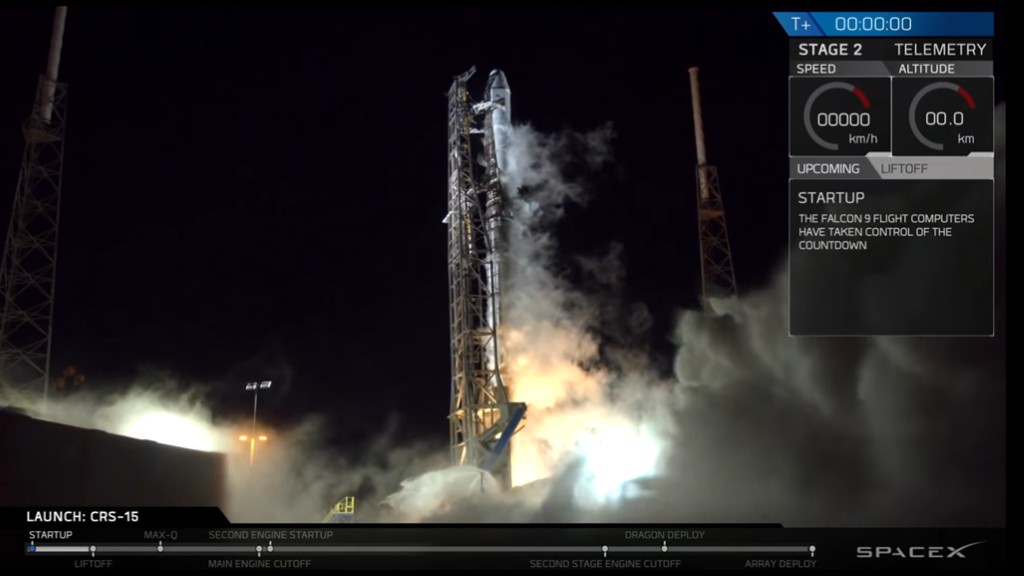
And then - at some point - we ended up with more great video feeds and the sort of overlay graphics you see on major sports broadcasts.
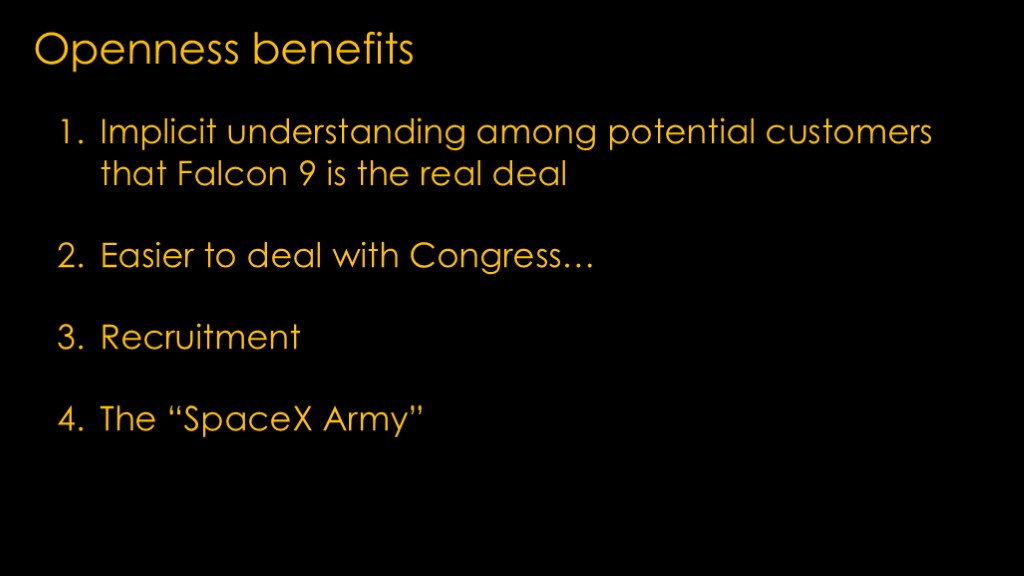
SpaceX got a ton of benefits of this.
First, there is implicit understanding among potential customers that Falcon 9 is the real deal. Commercial and air force payload people have already seen what SpaceX can do.
Second, easier relationships with congress, who holds the purse strings for NASA. A US company doing cool things in Space is a very useful talking point for politicians.
Third, recruitment. The high quality launch videos make it much, much easier to recruit people to come work at SpaceX.
Fourth, the SpaceX army. People who like spaceflight but had frankly become bored with the shuttle program.
SpaceX defined Spaceflight 2.0
SpaceX doesn't need to do conventional public relations work because the openness works so well.
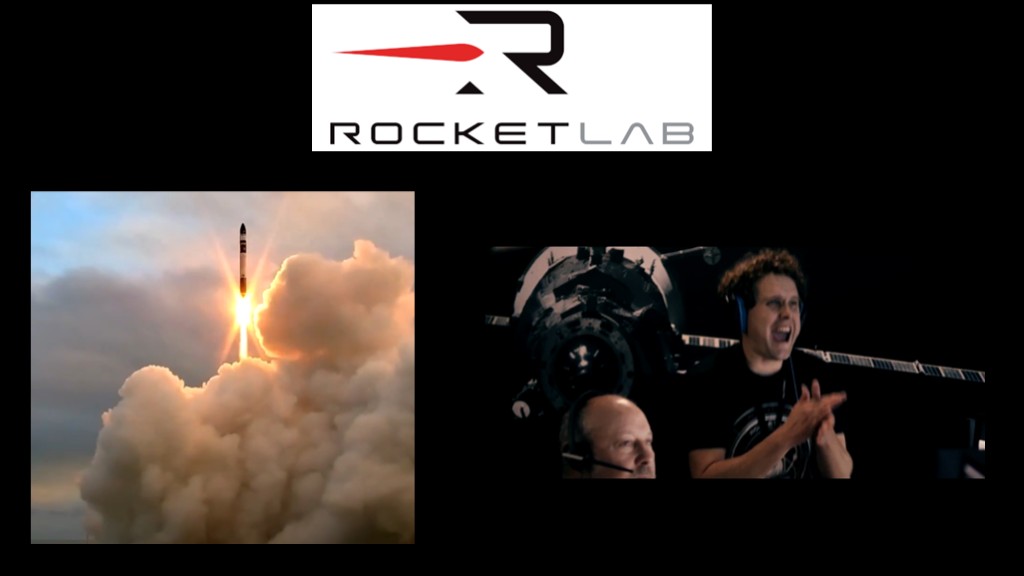
A few years later, Rocket Lab followed in SpaceX's footsteps. Being a company with a small rocket they launch out of New Zealand (where?), they needed as much help as possible. Their first flight launch day video is wonderfully produced.
https://www.youtube.com/watch?v=VA_8HPsua0c

So why isn't everybody as open as SpaceX?
The answer is simple.
It's a major pain.
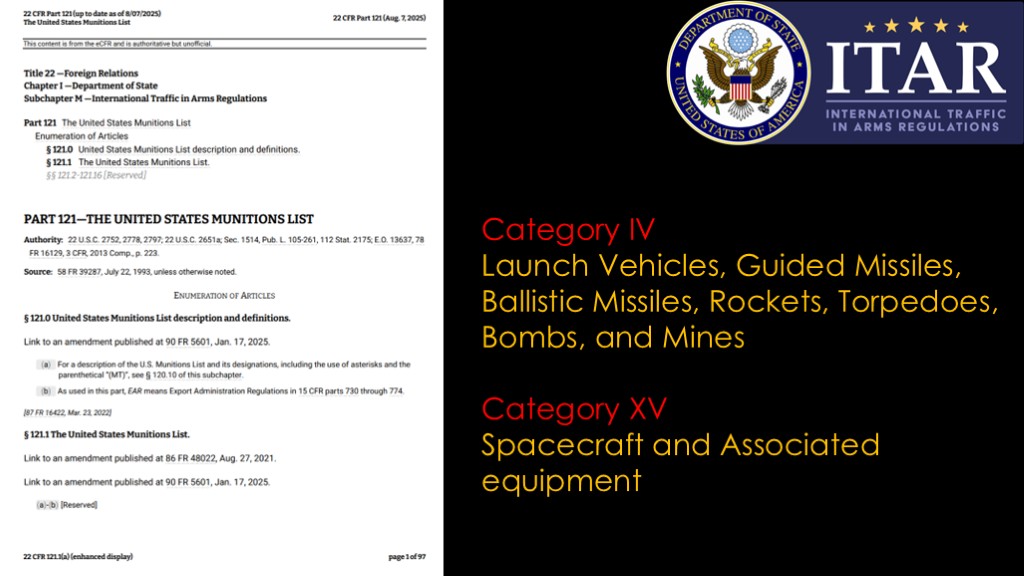
The first problem is ITAR, the international traffic in arms regulations, which is intended to prevent US technology from falling into the wrong hands.
It's a complex document.
Most space companies are subject to Category IV - launch vehicles, guided missiles, ballistic missiles, rockets, torpedoes, bombs and mines - or category XV - Spacecraft and associated equipment - or perhaps both.
For this discussion, we aren't concerned about export restrictions.

We care about the prohibition in sharing technical data, and yes, "I saw it in a video you sent out" or "I saw it in a video somebody else took" counts as sharing.

There are exclusions.
Information that is in the public domain, fundamental research, and educational information is excluded.
So here's the problem...
This is an extremely high resolution picture of the three versions of raptor. Does it fall under ITAR or not?
If you want to be open about what you are doing, those sorts of questions are going to come up over and over. And starship has attracted people whose full-time job is watching what SpaceX is doing at starbase from ground cameras or from the air. SpaceX has to make sure that that access does not lead to ITAR violations.
And ITAR has some real teeth - criminal charges for ITAR violations can results in fines of up to $1 million per incident and imprisonment for up to 20 years.
This means that you need people who are dedicated to working to limit the amount of exposure you have and people know who to apologize to in the cases where the process goes wrong.

The second issue is protecting your intellectual property. There are two main ways to do this.
In a patent, you describe your invention and then you have legal protection against anybody using your idea without licensing it, for a period of 20 years. At least in the countries where you hold a patent.
It's expensive but provides very good protection.
Your other option is a trade secret. In that case, you just don't tell anybody about what you want to protect. It's cheap and easy, but if you accidentally disclose it or somebody just figures it out and starts using it, you have no protection.
That would seem to make patents the approach of choice. But there's a problem...

The problem is that while China is a signatory to international patent treaties, their patent trial and appeal board is set up to further the aims of the Chinese government.
They also follow a "first to file" approach, rather than first to develop. That means that you can show up in China and find out that not only have they stolen your IP, they have patented it in China, preventing you from even selling your product there.
Given this, what would we expect to find for the patent behavior of launch companies?
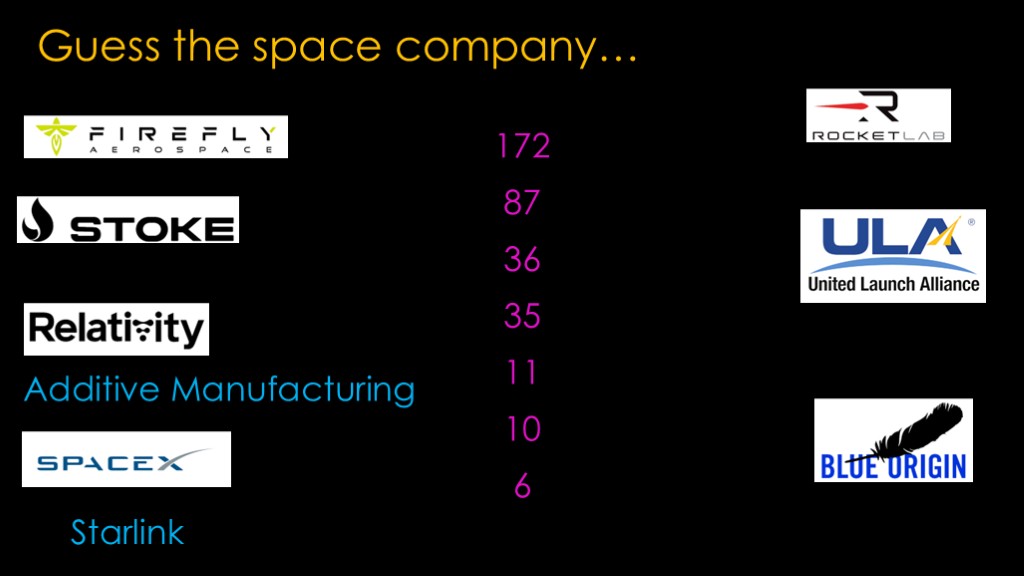
I went out and looked at the number of patents for a number of different space companies. Your job is to guess which company has a specific number of patents. All of these companies have a considerable amount of intellectual property they want to protect, and the number of granted patents can give us some insight into their approach.
We start at 6 patents, and that belongs to firefly.
Up next at 10 patents is stoke.
11 patents for Rocket Lab, and some of those are from companies that they acquired.
Three companies who really aren't using patents.
Next up with 35 patents is relativity, and 36 for ULA.
Only two companies left. 87 patents for SpaceX and 172 for blue origin.
Elon Musk is famously against patents because of the Chinese issues, so that number was surprising. But there are a few things to note about the *kind* of patents.
The relativity ones are almost exclusively about additive manufacturing.
For SpaceX, there was one patent for the Merlin engine, one patent for COPV pressure vessels, and from what I can tell, all the rest of them are starlink.
My interpretation of the approach of Relativity and SpaceX is that they decided that the competitive benefits of patenting them in countries that follow patents was more important than the disclosure of the ideas to China.
That gives us Blue Origin as an extreme outlier in this world, generating far more patents than the others . Some people have noted that it's better to consider Blue Origin to be a think tank rather than a rocket company, and from that perspective their desire to patent makes more sense.
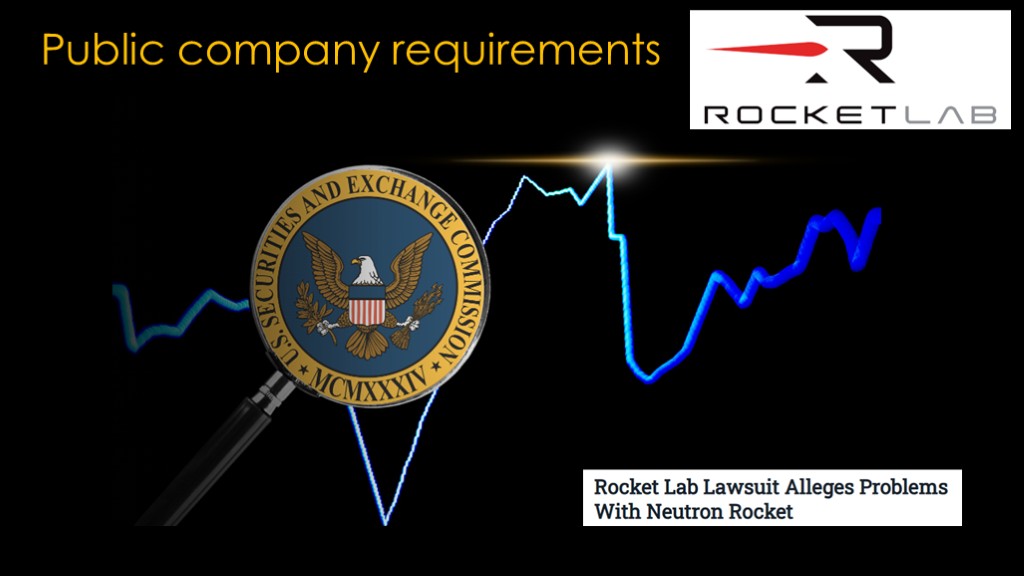
The final pain about being open is public company requirements.
If you are a public company like rocket lab, you are subject to rules around how and when you disclose material information.
If you do it wrong, you may be hearing from the securities and exchange commission, and even if you do it right, you may be subject to a shareholder lawsuit.
Those are the downsides, and that's why "work out in the open" isn't as easy as it sounds.
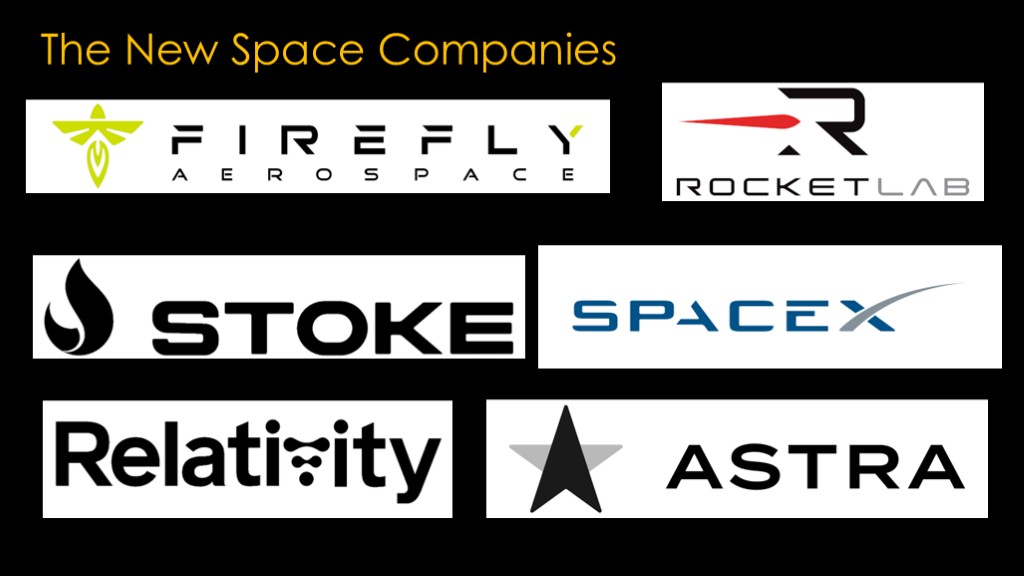
The new space launch companies all mostly land on the "more information" side.
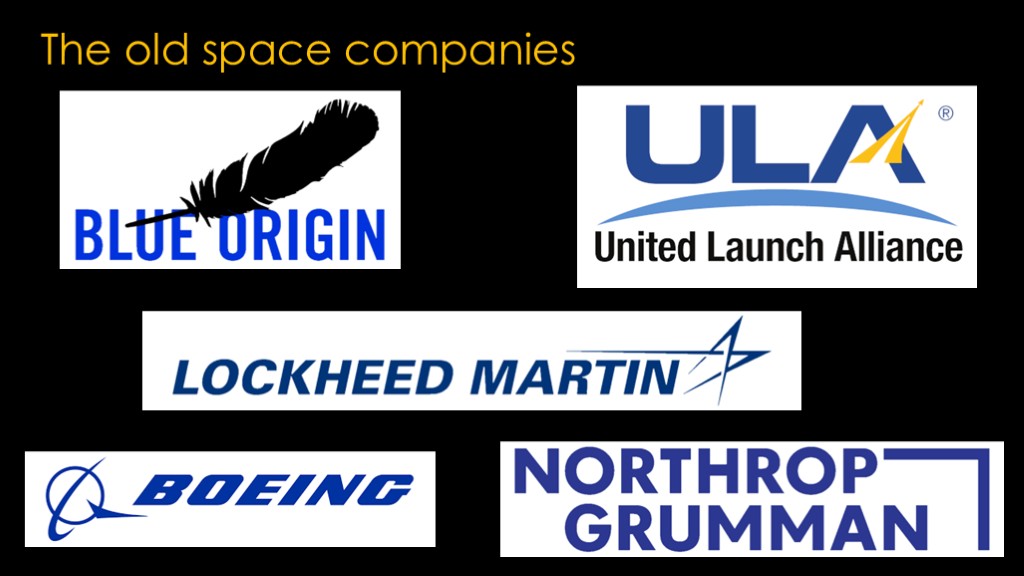
The old space companies are generally not that open.
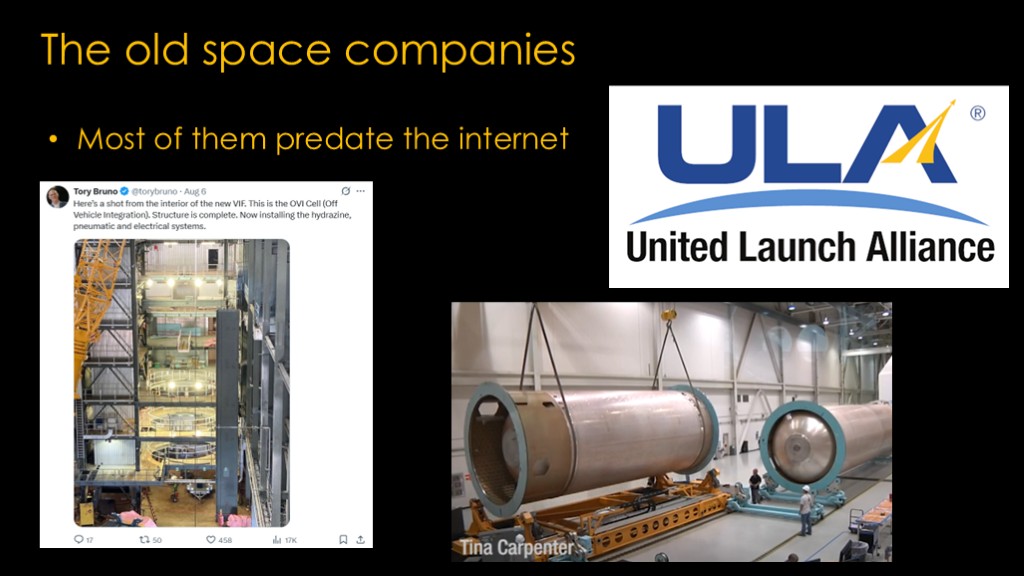
Most of them predate the widespread availability of the internet, and in the old days there was really no way to tell the people who might care about what you were doing, so that became the default model.
One exception is ULA, with Tory Bruno posting fairly often on TwiX, and ULA has also posted a nice series of videos called "what's it like..." and factory tours.
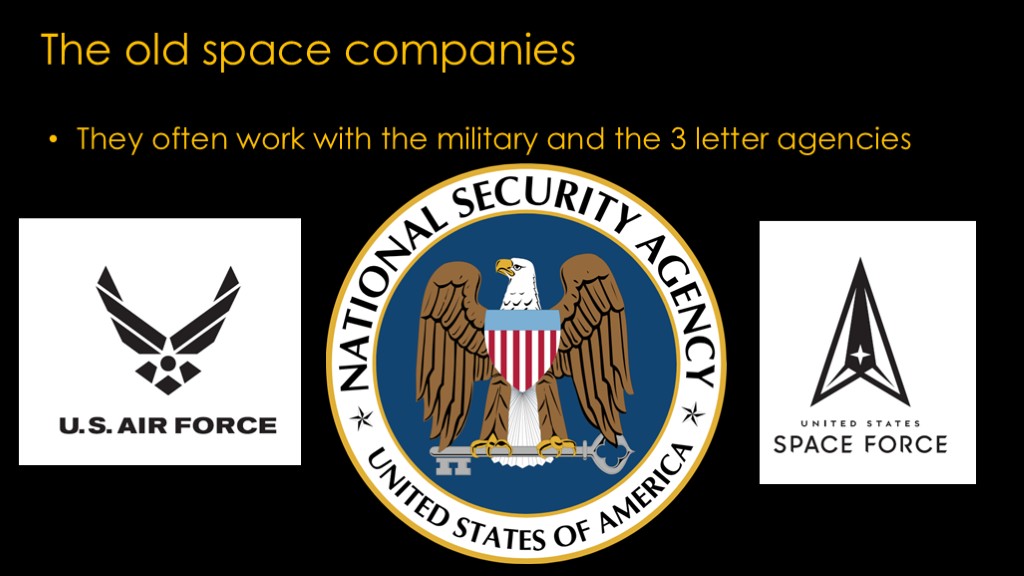
The old space companies often work with the military and the so-called 3 letter agencies like the NSA. That work is always classified and it's easier to not say anything than to put effort into figuring out what you are actually allowed to say.
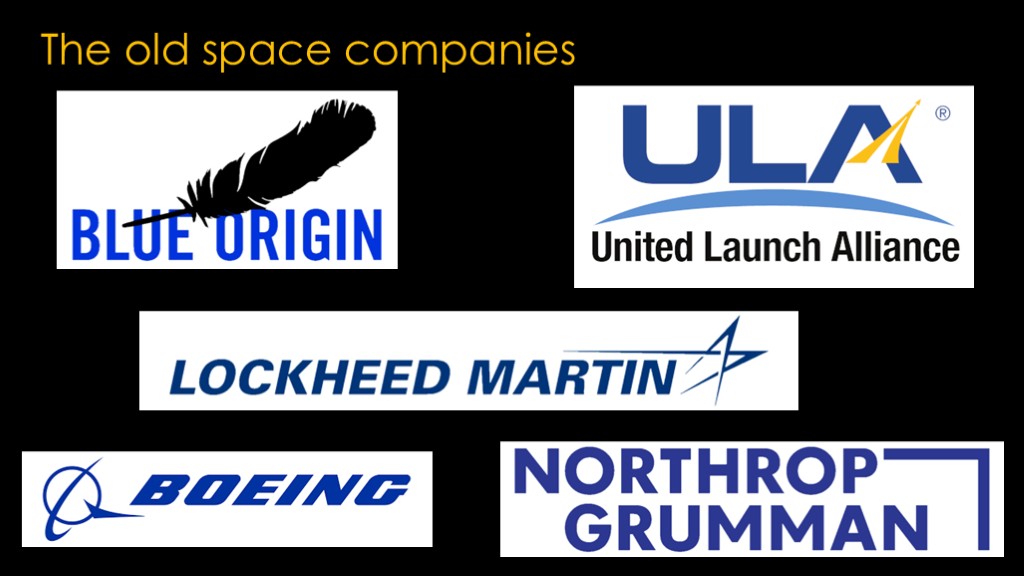
(dim out the others)
Which finally brings us to blue origin, and you might have wondered why it was listed as an old space company.
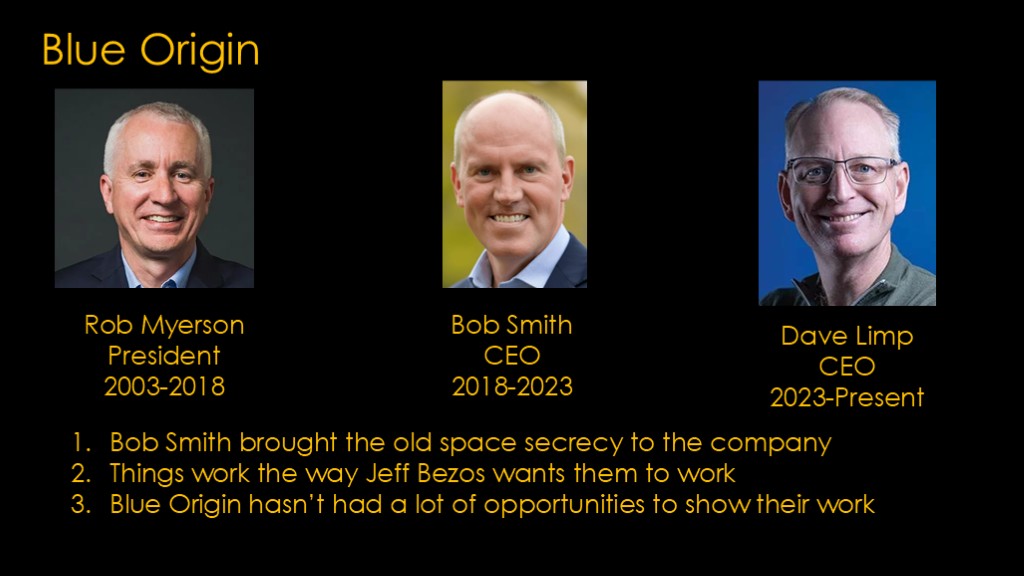
Blue Origin has a weird history for a new space company, where most companies are run by their founders.
From 2003 to 2018 Rob Myerson was running things, and he oversaw the development of New Shepard and the growth of the company from 10 employees to 1500 employees.
In 2018 Myerson left the company and was replaced by Bob Smith. Smith was a vice president at Honeywell Aerospace - one of the old space companies.
He was a bit of a strange choice, an old space executive coming to a company that had previously been more new space in culture. He instituted an old space mentality throughout the company.
In 2023 Bezos decide to replace Smith with Dave Limp, who was Senior Vice president for devices and services at Amazon and in charge of - among other things - Amazon's Project Kuiper satellite internet constellation.
I think there are 3 big factors in Blue Origin's secrecy.
The first is that bob smith brought the old space secrecy to the company. I think they have been a little more open in the past few years but I think secrecy is still their natural response.
Second, I think that things work the way Jeff Bezos wants them to work, and he wants secrecy. He did choose Bob Smith knowing what Honeywell was like and kept him on for 5 years.
Third, Blue Origin hasn't had a lot of opportunities to show their work beyond New Shepard flights as we have only seen one New Glenn flight.
Perhaps they will become more open as they have more to show.
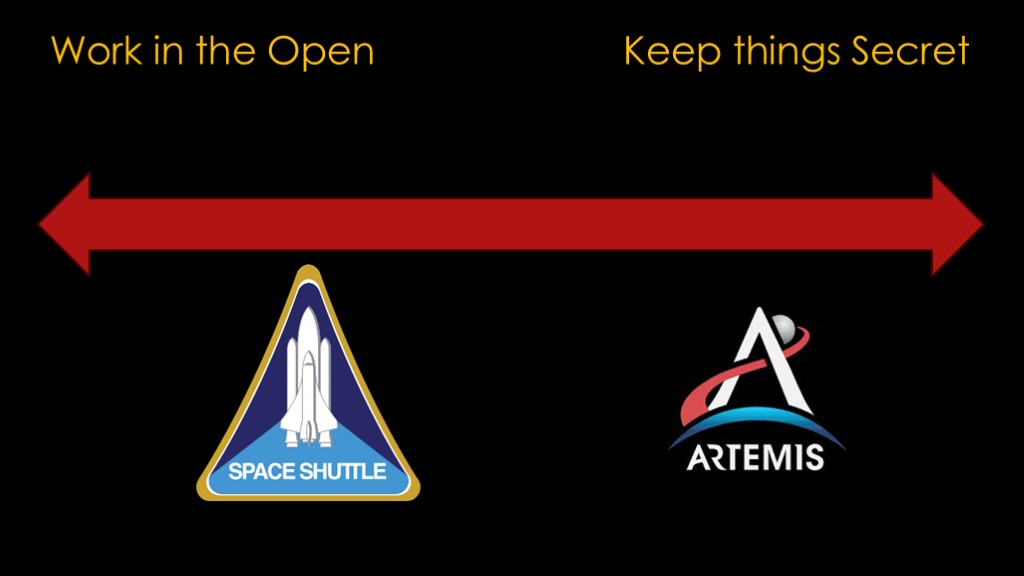
I've talked about this as if there are just two choices - working in the open or keep things secret, but companies exist all along the continuum based on how they evaluate the tradeoffs, and it's common for companies to be more open on one project than on other projects.
This same sort of thing goes on at NASA. If you've ever read any of the space shuttle mission reports, you know that NASA put a lot of effort into making sure they followed their congressional openness mandate and shared their information widely.
That is unfortunately not the case with Artemis, where there has been a concerted effort to hide issues and to operate in ways that make it difficult to get information even if you can make FOIA, or freedom of information act, requests for specific information.
Despite Artemis 1 being the first flight of a new launcher that NASA had been working on for well over a decade, NASA did not create a detailed mission report for Artemis 1, and we only know about issues because of the work of the NASA office of the inspector general and the General Accounting Office.
And that's what's driving openness and secrecy at space companies.

If you enjoyed this video, listen to this...
https://www.youtube.com/watch?v=JmGMzyajA2U